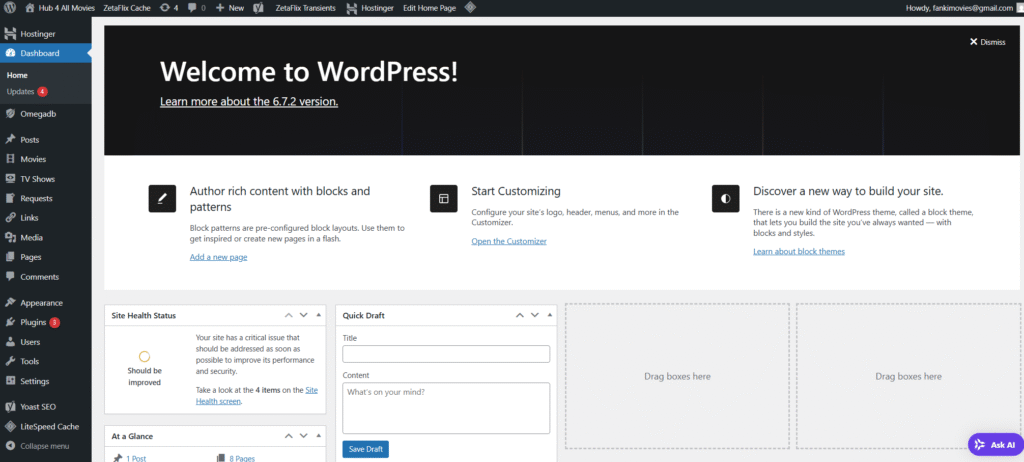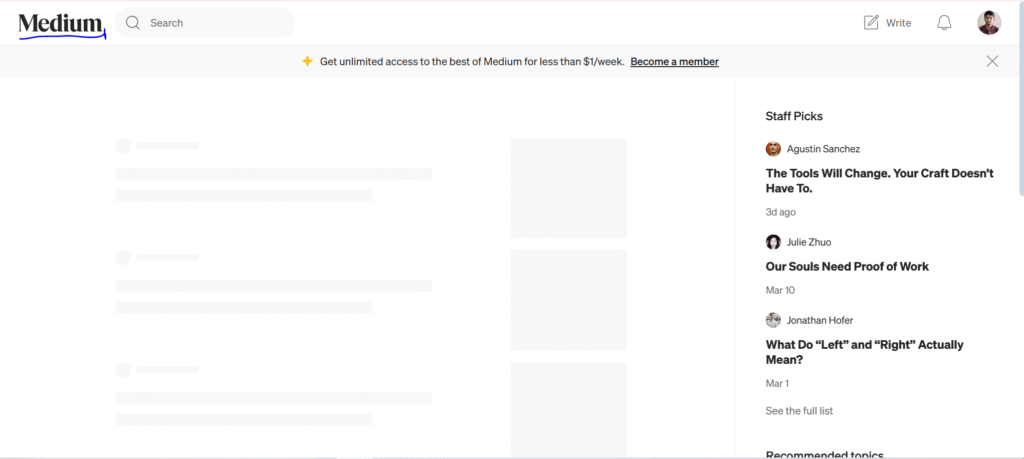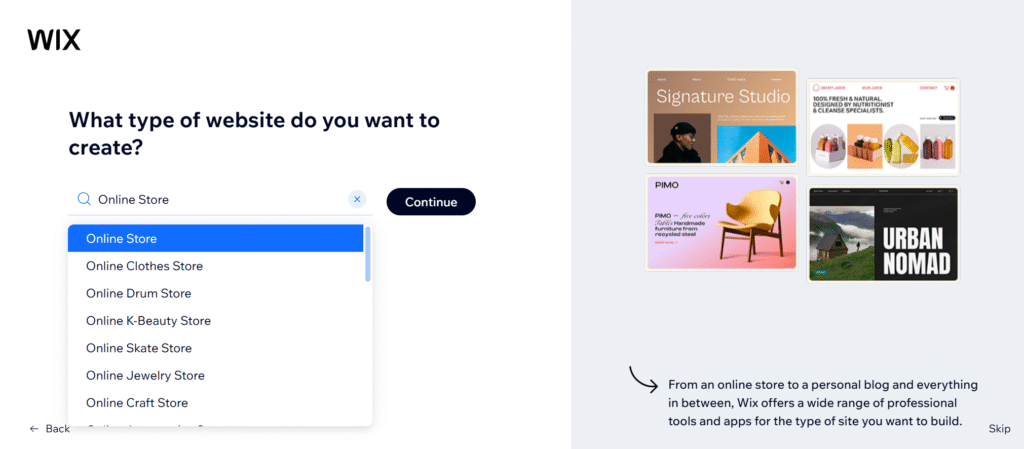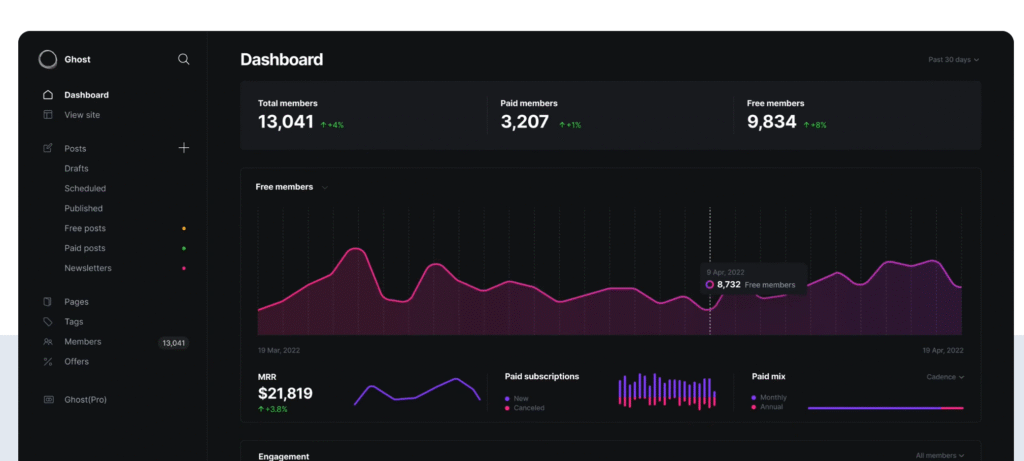In today’s world of digital the free blogging platforms have radically changed, offering features that used to require a significant financial investment. You may want to share your thoughts, establish your personal brand or even monetize your blog’s content, selecting an appropriate platform can be vital to your blog’s success. This guide will help you choose the top free blogging platforms in 2025, comparing their features, highlighting strengths as well as weaknesses, and assisting you to decide which one is best suited to your goals without spending a dime.
- What is a Free Blogging Platform?
- Why Choose a Free Blogging Platform?
- Perfect for Beginners
- Zero Financial Risk
- Quick Setup and Launch
- Minimal Technical Requirements
- Community and Built-in Audience
- Top 10 Best Free Blogging Platforms of 2025
- 1. WordPress.com
- 2. Blogger (Google Blogger)
- 3. Medium
- 4. Wix
- 5. Ghost Blogging Platform
- 6. Tumblr
- 7. Hashnode
- 8. Site123
- 9. Substack
- 10. LinkedIn Articles
- Best Free Blogging Platforms for Different Needs
- Best Free Blogging Platforms for Beginners
- Best Free Blog Sites to Make Money
- Best Free Blogging Sites for Students
- Best Free Blogging Platforms for Professionals
- Easiest Blog Platforms to Use (Free)
- How to Choose the Right Free Blogging Platform
- How to Monetize a Free Blog
- Affiliate Marketing
- Sponsored Content
- Digital Products
- Services and Consulting
- Platform-Specific Monetization
- SEO Capabilities of Free Blogging Platforms
- WordPress.com
- Blogger
- Medium
- Wix
- 5 Actionable Tips for Successful Blogging on Free Platforms
- Limitations of Free Blogging Platforms
- Branding Restrictions
- Design and Functionality Constraints
- Storage and Media Limitations
- Monetization Restrictions
- Ownership and Portability Concerns
- What is the best time to upgrade from a Blog Platform that is Free
- Growth Signals That Suggest Upgrading
- Cost-Benefit Analysis of Upgrading
- Migration Considerations
- FAQs About Free Blogging Platforms
- Is Blogger 100% free?
- Do I need to start blogging no cost?
- What is the cost Blogger pays per 1,000 impressions?
- Do blogs for free earn money?
- Which website is suitable for those who are just starting out?
- Is WordPress superior to Blogger?
- Conclusion: Choosing Your Best Free Blogging Platform in 2025
What is a Free Blogging Platform?
A blogging platform that is free is a service on the internet that lets users create and publish blog posts without the expense of hosting domain registration, hosting, as well as software licences. These platforms offer the basic infrastructure for publishing online, which includes hosting space basic design templates and publishing tools for core content – all for free.
“In my experience, understanding what you’re getting–and not getting–with a free blogging platform is essential before diving in,” expert blogger Sara Jensen. “Free doesn’t mean without limitations, but it can mean incredible value for the right blogger.”

Blog platforms for free generally can be classified into two broad categories:
- Hosted platforms: Services like Blogger, WordPress.com, and Medium that host your blog on their servers, typically with a subdomain (yourname.blogspot.com, yourname.wordpress.com)
- Website builders that include blogging features Platforms like Wix and Site123 which provide more capabilities for building websites, including integrated blogging capabilities
The main difference between paid and free blogging platforms is the limitations they place in terms of customization, monetization options storage space, as well as branding. While free platforms offer the necessary tools to begin blogging quickly, they usually impose limitations on how you expand and make money from your blog.
Here’s how paid and free blogging platforms usually contrast:
Why Choose a Free Blogging Platform?
Beginning with a free blogging platform can provide a number of advantages, especially for those who are just starting their blogging journey.

Perfect for Beginners
Free platforms are a simple starting point that has user-friendly interfaces specifically designed for users who aren’t technical. Many offer easy drag-and-drop editors as well as pre-designed templates that make the creation of a beautiful blog easy.
“What I learned the hard way is that many beginners waste months trying to perfect a self-hosted blog with all the bells and whistles, when they should be focusing on creating content and building an audience first,” Digital marketing expert James Peterson.
Zero Financial Risk
The most obvious benefit is the absence of an initial investment. This entry point is low-cost and lets you explore blogging without the need to invest in financial resources. It is ideal to see if blogging fits with your needs prior to investing in premium software.
Quick Setup and Launch
The majority of free blogging platforms allow you to set up an account and publish your first blog post in a matter of minutes. This allows you to concentrate on content development instead of technical configuration.
Minimal Technical Requirements
Free platforms take care of all technical aspects of hosting and security as well as software updates. This managed environment removes the requirement for technical knowledge in the management of servers the configuration of databases, as well as maintenance of software.
Community and Built-in Audience
Certain free blogging platforms such as Medium provide the benefit of a reader-based community and the possibility of connecting your blog with readers interested in your content faster than creating a new blog using a self-hosted platform.
Top 10 Best Free Blogging Platforms of 2025
After experimenting with a variety of different platforms, and analyzing feedback from users across Reddit professional reviews and blogger communities, I’ve put together this list of the top free blogging websites in 2025. Each platform has its own advantages to different kinds of bloggers.
1. WordPress.com

WordPress.com is still the most popular choice for blogging without cost by 2025, providing an outstanding balance of usability as well as flexibility and potential for growth.
Key Features:
- Block editor that is intuitive and easy for content creation
- Responsive designs and a variety of themes for free
- Social sharing built-in
- SEO basics SEO tools
- 3GB of storage available on the free plan.
- Building community through comments and shares
Pros:
- Clean, professional designs
- Fantastic mobile experience
- Possibility of upgrading as your blog expands
- Achieved strong capabilities in managing content
- Solid community support
Cons:
- WordPress.com branding on the free plan
- Limits on customization options and no upgrade
- There are restrictions on the monetization (no third-party advertisements)
- Integration of plugins is not available on the free level
is ideal for Bloggers who require an attractive platform that allows the possibility of growth and an upgrade in the future.
Monetization options: Limited on free plan; mostly limited to affiliate hyperlinks as well as sponsored material.
2. Blogger (Google Blogger)

Google’s Blogger platform continues to provide one of the most simple and free blogging experiences you can get by 2025.
Key Features:
- Tight Google product integration
- Pages and posts that are unlimited
- 1GB of storage space for images and documents
- Basic templates that allow for only a few customization options
- AdSense integration to monetize
- Free hosting with Google’s secure infrastructure
Pros:
- Free for all users without upsells
- Simple and simple interface
- Reliable Google hosting
- Direct AdSense monetization
- Custom domain support is available even when you are on a free plan
Cons:
- The interface is outdated and there are design options
- Limited SEO control
- Less features than competitors
- Infrequent platform updates
- Community support is lower than WordPress
is ideal for Content-driven bloggers who require a simple and reliable platform that offers direct revenue options.
Marketing Options Google AdSense integration and affiliate marketing, sponsored posts.
3. Medium

The Medium platform has grown by 2025, offering an improved platform for writers looking for quality readers without the technical issues.
Key Features:
- A beautiful, non-distractional writing interface
- A built-in distribution and audience
- Partner Program to earn writer income
- The social network aspect of followership
- Professional layout and typography.
- Analyses on the performance of a post
Pros:
- Write primarily Not technical issues
- The potential to reach large audiences via Medium’s algorithm
- Earning opportunities Through the Partner Program
- Professional appearance, with no design work
- A great mobile experience on mobile phones
Cons:
- Customization options are limited.
- No custom domains on the free plan
- Platform controls content distribution
- Competitors’ content could appear in conjunction with yours
- A lesser degree of control over strategies for monetization
Ideal for: Writers who are focused on building audience and content quality, rather than the customization of websites or other ways to monetize.
Optional Monetization: Medium Partner Program Based on the time spent by the member reading.
4. Wix
Wix’s blogging program for free has grown increasingly competitive since 2025. It offers strong website building capabilities and blogging features.

Key Features:
- Drag-and-drop site builder
- 500+ designer templates
- Mobile optimization
- App market that offers premium and free extensions
- SEO tools and guidelines
- 500MB of storage
Pros:
- A highly visual and easy to use interface
- Professionally-designed templates
- Website functionality extends beyond blogging
- Advanced design control with no Coding
- Excellent responsive designs
Cons:
- Wix ads on sites for free
- Limited storage (500MB)
- No custom domains on the free plan
- Some features require premium plans
- It can be overwhelming due to too many choices
Ideal for: Blogs that are visual and require control of their designs and may require more website pages in addition to the blog.
Payment Options Limited in free version; mostly advertising and sponsorship.
5. Ghost Blogging Platform
Ghost’s blogging approach is based on simplicity and content-focused focus and is free, thanks to its service accessible through Ghost’s open source version.

Key Features:
- Clean, minimalist design
- Markdown editor based on Markdown
- Created to meet the needs of professional publishers.
- The ability to join and subscribe
- SEO optimized structure
- Developer-friendly
Pros:
- A distraction-free writing experience
- Modern, fast-loading designs
- Built-in SEO best practices
- Good typography and readability
- Foundation Open-Source
Cons:
- Free version requires self-hosting expertise
- More rapid learning curve than competitors
- Theme selection is limited as compared to WordPress
- Less integrations than the larger platforms
- Community support is more important than direct support
Ideal for: Bloggers with a bit of technical expertise who value the presentation of content and its performance.
Optional Monetization: Members, memberships and sponsorships.
6. Tumblr
Despite its time, Tumblr continues to offer an unique microblogging platform, with a an emphasis on community in 2025.
Key Features:
- Microblogging with a multimedia emphasis
- Community interaction and reblogging
- Simple post creation via typing (text image, text quotes, text, etc.)
- Follower and following system
- Mobile-friendly interface
- Tagging system for content discovery
Pros:
- Strong community engagement
- Simple multimedia sharing
- Fantastic mobile experience
- Ideal for content with a short form
- Built-in social network
Cons:
- Limited long-form blogging capabilities
- A smaller number of professional templates
- Less SEO control
- Platform’s reputation is less business-oriented
- Limited analytics
is ideal for: Creative bloggers focusing on visual content, writing in short form and social interaction.
Optional Monetization: Tips jars, Affiliate Marketing or sponsored content.
7. Hashnode
Hashnode’s popularity has increased significantly since 2025, providing a user-friendly, accessible and developer-friendly platform that is a strong community feature.
Key Features:
- Environment that is friendly to developers
- Support for custom domains (even with a free plan)
- Markdown editor
- Community built-in
- Newsletter function
- Analytics dashboard
Pros:
- A strong technical community
- Custom domains can be used for no cost
- No advertisements on platforms
- Content creation that is code-friendly
- The control over URLs that can be used as Canonical
Cons:
- The more technical focus could be a source of fear for users who aren’t technical
- Less design options for designers that WordPress or Wix
- Tech-focused community primarily.
- Tools for marketing that are not as extensive
- Less integration options
Ideal for: Tech bloggers, particularly those working in software development who wish to be seen by the community as well as customized domain support.
Optional Monetization: Affiliate marketing, sponsorships indirect professional and sponsorship opportunities.
8. Site123
Site123 is one of the easiest ways to create a blog for free by 2025.
Key Features:
- Web Builder with Blog functionality
- Responsive templates
- Simple editor interface
- Multi-language support
- SEO basics SEO tools
- 500MB of storage
Pros:
- Very simple to utilize
- Quickly set up procedure
- Professionally designed templates
- Good multilingual support
- A helpful guide to create the process
Cons:
- Site123 branding on sites that are free
- Limited storage (500MB)
- A few more advanced blog features
- No custom domains available on the free plan
- A little less flexible than some competitors.
The best choice for Beginners who value simpleness and simplicity over features that are more advanced.
Option to Earn Money: Limited to affiliate marketing and sponsored content in the free plans.
9. Substack
Although they are primarily renowned for its newsletters, Substack has expanded its free blogging capabilities to 2025.
Key Features:
- A blog and newsletter platform that is combined
- Clean, distraction-free design
- Built-in subscription management
- Tools to build an audience
- Analytics dashboard
- Integration of podcasts
Pros:
- Direct connection to readers via email
- Straightforward monetization path
- Strong community characteristics
- Simple, clean design
- Distribution and sharing is easy.
Cons:
- Primarily focused on newsletters over traditional blogs.
- Limited design customization
- Platform takes a percentage of subscriptions paid for
- Less SEO optimization tools
- Insufficient integration with other services.
is ideal for: Writers building an audience via blog posts and newsletter content, with the potential to pay for subscriptions.
Payment Options Subscribers to the Reader with Substack receiving the form of a percentage.
10. LinkedIn Articles
Although it is not a traditional platform for blogging LinkedIn’s Articles feature has increased by 2025 to offer professional bloggers with access to corporate audiences.
Key Features:
- Professional networking integration
- CV/resume connection
- Business audiences are the focus
- Distribution of content through the LinkedIn network
- Analytics on performance of the post
- Professional profile enhancement
Pros:
- Direct connection to a professional network
- Personal branding benefits
- No technical setup is needed
- Professional opportunities that could be a possibility
- Built-in distribution
Cons:
- It is not a specific blogging platform.
- Limited design customization
- The focus of professional content may limit the topics
- There aren’t any direct options to monetize
- Content ownership questions
Ideal for: Professional bloggers, thought leaders, and people writing about careers, work or other industry-specific subjects.
Opportunities to Earn Money: Indirect through professional opportunities and personal branding.
Best Free Blogging Platforms for Different Needs

Each blogger has different needs. Let’s look at which platforms are best for specific scenarios.
Best Free Blogging Platforms for Beginners
For those who are just beginning their blog simplicity, user-friendliness and the minimum technical requirements are essential.
- WordPress.com – Offers the ideal balance between accessibility and growth potential for the future.
- Blogger Very easy to use with only minimal configuration needed
- Site123 – The setup process is guided and ensures it is virtually impervious to error
- Wix – Visual editor helps beginners create professional-looking blogs
“Here’s a tip I always give beginners: start with a platform that grows with you rather than one you’ll outgrow quickly,” says the content strategy expert Maria Chen. “WordPress.com might take an extra 30 minutes to learn, but you’ll save countless hours down the road when you don’t need to migrate.”
Best Free Blog Sites to Make Money
Options for monetization vary widely on free platforms.
- Blogger – Direct AdSense integration makes monetization straightforward
- Medium – Partner Program permits the earning of members based on their time spent reading
- WordPress.com – Limited on the free plan, however clearly defined upgrade path to real commercialization
- Substack – A subscription model for writers who have committed audience
When you think about monetization, be aware that free platforms generally limit certain revenue streams or accept an amount of the revenue. If you are looking for a significant income one day, you might have to think about moving to a paid subscription or a self-hosted service.
Best Free Blogging Sites for Students
Students usually require simplicity and academically-friendly features.
- Medium – Professional look with only a minimal set-up
- WordPress.com – Excellent for more academic content
- Tumblr is great for sharing creative portfolios as well as sharing of projects
- Hashnode – Perfect for students studying computer science and programming projects
Educational institutions may offer specific platforms or recommendations to bloggers, so make sure your school provides hosting or blogging tools prior to choosing a platform for public use.
Best Free Blogging Platforms for Professionals
Professional networking.
- LinkedIn articles Direct integration with the professional network
- Medium Professional appearance and the potential to increase visibility for your business
- Ghost (open source) – Minimalist design projects professionalism
- WordPress.com – Flexible enough for professional content, with room for growth
Professional bloggers must be aware of how their blog’s image affects their personal brand, and whether it is able to connect them with the right people in their field.
Easiest Blog Platforms to Use (Free)
To those who place simplicity first over anything other things.
- Site123 The process of creating it is guided. ensures it is nearly impervious to error
- Blogger Straightforward interface with a few options to cause confusion
- Medium – Concentrate solely on writing and not worry about technical issues
- Tumblr Simple posting via content type
“In my experience testing dozens of platforms with beginners, the biggest predictor of blogging success isn’t features–it’s whether someone actually publishes content consistently,” says blogger trainer Thomas Rivera. “The easiest platform is whichever one doesn’t intimidate you into procrastination.”
How to Choose the Right Free Blogging Platform
Finding the right free blogging platform will require careful consideration of your requirements and objectives. Here are five important factors to consider:
- Define Your Blog’s Purpose Do you want to blog as a pastime or to build an impressive portfolio for professional use, to earn money from content, or enhance the business? Different platforms excel at different purposes.
- Check Your level of comfort Be open about your willingness to study technical aspects. If you’re looking for a simple experience platforms such as Blogger or Medium may be better than WordPress.com despite WordPress’s superior capabilities.
- Take into consideration your design priorities If unique branding and design alterations matter significantly, Wix or WordPress.com offer greater flexibility than Medium and LinkedIn Articles.
- Assess the potential for growth Take into consideration whether you will surpass the capabilities of the platform. Do you have the ability to export your content in a matter of minutes? Are there clear upgrades route? WordPress.com is a top choice for this by offering a migration path for self-hosted WordPress.
- Analyze Features for Building Audiences Certain platforms such as Medium or LinkedIn Articles come with built-in distribution networks, while other require you to construct an audience by starting from the ground up.
How to Monetize a Free Blog
Although free blogging platforms typically limit monetization options, in comparison to self-hosted alternatives there are a variety of revenue-generating strategies readily available
Affiliate Marketing
A majority of platforms permit affiliate marketing, in which you earn a commission by suggesting items or products. Amazon Associates, ShareASale, and other affiliate networks may generate income, but without violating the majority of platforms’ terms of service.
Pro Tips Make sure to focus on products which are relevant to your audience and content. Be transparent about affiliate relationships to keep trust in readers and to comply with the rules.
Sponsored Content
As your blog expands as it grows, businesses can pay you to write content that promotes the products and services they offer. The majority of free platforms permit sponsored posts, with the proper disclosure however certain platforms (like Medium) have particular guidelines.
Tips Keep editorial standards in place for sponsored content. Readers will be able to detect when you’re really passionate about something, and not just taking a pay check.
Digital Products
Selling ebooks or courses, templates, or other digital items is possible on most blogging platforms. The most common way to sell digital products is through linking with an online sales website, rather than selling directly from your blog.
Pro Tips Utilize your blog to build expertise prior to launching new products. Content that is free and valuable creates the trust needed to ensure the success of sales.
Services and Consulting
Your blog can be used as an evidence of your skills, and could lead to speeches, or customers.
Pro Tips: Create a noticeable “Work With Me” or “Services” page with clear details on how your readers are able to hire you.
Platform-Specific Monetization
Some platforms offer unique monetization paths:
- Medium: Partner Program pays members based on the time spent by members reading
- Substack: Subscription model for recurring reader payments
- Blogger Google AdSense integration: Direct Google AdSense integration
- Tumblr Tip Jar functionality for contributions by readers
SEO Capabilities of Free Blogging Platforms

The capabilities of search engine optimization differ significantly between free blogging platforms, which could impact the visibility of your blog’s content:
WordPress.com
WordPress.com provides an excellent set of SEO foundations with its free plan. It includes:
- Meta descriptions
- Clean URL structures
- The responsiveness of smartphones (critical in SEO)
- Sitemaps XML
- Good page loading speeds
The free plan isn’t equipped with the most advanced SEO plugin support, as well as certain customisation options that are available in paid plans.
Blogger
Google’s Blogger offers the basic SEO functions:
- Google Search Console integration
- Customized permalink structures
- Meta tag editing
- Templates that are mobile-friendly
- Automatic indexing (as as a Google product)
Its most important SEO drawback is the lack of options for customization and a slightly outdated infrastructure.
Medium
Medium prioritizes quality content over traditional SEO with the help of:
- A high domain authority can benefit your content
- Fast-loading, clean pages that load quickly and cleanly.
- Implementation of structured data
- Internal distribution system for internal distribution
- The SEO elements are not customizable. SEO elements
The platform is responsible for the majority of SEO aspects, which makes it less adaptable, but more effective in certain areas.
Wix
The Wix free plan comes with an amazingly powerful SEO tools:
- Wix SEO Wiz setup guide
- Customizable meta tags
- Control of the URL structure
- Alter text to images
- Mobile optimization
However, the free Wix websites display advertisements from platforms that can impact the metrics of user experience that are crucial to SEO.
5 Actionable Tips for Successful Blogging on Free Platforms
- Focus on Content Quality Over Quantity
Establish a reputation for quality rather than just posting regularly. For platforms such as Medium or LinkedIn Articles, algorithm success typically depends more on engagement metrics than post quantity. Be sure to write thorough, well-studied pieces that truly help your intended audience. - Cross-Promote Across Social Platforms
Most free blogging platforms have a few tools to build audiences. You can compensate by sharing your content via social media platforms that your intended audience is spending time. Create specific platforms for your content instead of distributing identical content across all platforms. - Build an Email Subscription Option
Even if your blogging platform isn’t able to allow native email subscriptions, utilize a solution like MailerLite as well as ConvertKit with integrated sign-up forms. Email lists offer a an audience that is platform independent and remains yours even if you switch blogging platforms in the future. - Network Within Platform Communities
A majority of blogging platforms for free include internal communities as well as engagement mechanisms. On Medium, interact with other writers through commenting carefully. On Hashnode take part in discussion and contests. These community connections are often your first readers who are loyal to you. - Create Topic Clusters, Not Random Posts
Create the content plan around topics to establish your expertise in particular areas. This strategy builds authority in your topic for SEO and assists readers in discovering more relevant content. For instance, instead of unrelated finance articles, you can make a cluster about “Investing for Beginners” with several related posts.
Limitations of Free Blogging Platforms
While blogging platforms for free offer enormous value, understanding their limitations allows you to create realistic expectations.
Branding Restrictions
A majority of platforms for free display their own logos on your blog. Usually, this is by using:
- Platform-branded subdomains (yourblog.wordpress.com)
- Text in the footer (“Powered by …”)
- Sometimes, banner ads
- Logo and favicon options are limited.
These elements compromise professionalism and control of the brand in comparison to paid options.
Design and Functionality Constraints
Free plans generally limit options for customization and features.
- Theme or template selection is limited.
- Options for plugins and widgets that are restricted
- Fewer layout configurations
- The basics of typography as well as color control
- Interactive elements with limited functionality
WordPress.com for instance, has over 250 themes in paid plans, with only a tiny fraction of these available on the free tier.
Storage and Media Limitations
Media constraints can affect content quality:
- WordPress.com Limit of 3GB storage
- Site123 and Wix 500MB storage
- Blogger 1GB for photos (15GB that are shared by Google products)
- Video hosting is generally not available or not available
- Upload restrictions on file type
This limitation could affect podcasts with a lot of images the most dramatically.
Monetization Restrictions
Platforms that are free typically limit opportunities for revenue:
- WordPress.com does not allow third-party advertisements
- Medium manages monetization through its Partner Program
- Many platforms limit or ban certain affiliate programs.
- The functionality of E-commerce typically requires updates
- Restrictions on promotional content
Ownership and Portability Concerns
Content ownership differs depending on the platform:
- Terms of service can confer certain rights on platforms to your content
- The capabilities of exporting differ greatly among services.
- SEO equity built up on subdomains might not transfer when you change your domain
- Relationships between subscribers and followers may depend on the platform.
- Certain platforms are able to remove content that is contrary to the ever-changing guidelines.
What is the best time to upgrade from a Blog Platform that is Free
If your blog is growing There are a variety of indicators that suggest it’s the right the time to think about an paid plan or self-hosted solution:

Growth Signals That Suggest Upgrading
- reaching storage limits Invariably bumping up against storage limits for media files
- Limitations on Monetization Limiting revenue opportunities due limitations on the platform
- Design Discontents Repetually wishing for customisation options that are not available in free plans
- Professional Appearance requirements Sponsors or clients commenting on branding of the platform
- traffic growth experiencing problems with performance when traffic increases
“What I learned the hard way is waiting too long to upgrade actually cost me more in lost opportunities than I saved in monthly hosting fees,” writes the professional blog of Karina Westfield.
Cost-Benefit Analysis of Upgrading
If you’re considering a upgrade Consider:
- Potentially additional revenue in comparison to. cost of upgrades
- Time savings from better workflows and tools
- Professional impression advantages for your brand
- Improvements in performance to improve the user experience
- Benefits of ownership and control over the long term
Migration Considerations
Before upgrading, consider:
- Transferability of Content (export/import capabilities)
- SEO Impact of changing domains
- Learning curve for systems that are new
- Time investment is needed to make the migration
- The possibility of temporary disruptions in traffic
Most established platforms offer migration paths, but the process complexity varies significantly–WordPress.com to self-hosted WordPress being among the smoothest transitions.
FAQs About Free Blogging Platforms
Is Blogger 100% free?
Yes the Google Blogger platform is completely free, with no extra charges or paid tiers. It lets you create unlimited pages, posts as well as up to 1GB of storage for images (which will share the 15GB allocated to your Google account’s 15GB allowance). Blogger also allows you to create a customized domain connections without an upgrade fee, which makes it among the few genuine “free” platforms available.
Do I need to start blogging no cost?
Absolutely. Many top-quality platforms allow bloggers to start their blogs completely for free. WordPress.com, Blogger, Medium, Wix, Hashnode, and many others provide free plans that have enough features for novices to start and manage quality blogs. These plans are typically free and include hosting basic design templates and publishing tools essential to start your blog without a financial expenditure.
What is the cost Blogger pays per 1,000 impressions?
Blogger does not pay for views. Instead, it permits the direct connection with Google AdSense, where earnings vary greatly based on the audience’s location, niche and type of content. In 2025, average AdSense rates are between $1 and $3 per 1,000 views for the majority of subjects, with the potential for higher rates in profitable niches such as insurance, finance or certain high-value industries. Your actual earnings will be contingent on the level of engagement that visitors receive from ads as well as the ads that are targeted to your content.
Do blogs for free earn money?
Yes, blogs that are free are able to earn money, but generally less than self-hosted blogs due to limitations on platforms. Most monetization options for blogs for free include advertising on affiliate sites or sponsored content, selling digital goods or services as well as platform-specific programs such as Medium’s Partners Program. The income potential depends greatly on your content quality, niche selection, audience engagement, and which free platform you choose–with some being significantly more monetization-friendly than others.
Which website is suitable for those who are just starting out?
For those who are just beginning, WordPress.com offers the best combination of ease of use and growth potential by 2025. The block editor is easy enough for novices, while offering the best upgrade route as their skills improve. For those who want to be as simple as possible Blogger needs almost no technical skills and remains totally free. Site123 provides one of the easiest guided set-up process. Medium lets beginners focus only on writing, with no technical or design considerations.
Is WordPress superior to Blogger?
WordPress.com generally provides more advanced features, superior design options, and more potential for growth than Blogger and is therefore a better choice for those with long-term plans. But Blogger is excelling in a few areas: it’s free of upsells, offers custom domains for free plan, provides the direct AdSense Integration, and needs less technical expertise to manage. The “better” platform depends on your specific priorities–WordPress for growth and design flexibility, Blogger for simplicity and straightforward monetization.
Conclusion: Choosing Your Best Free Blogging Platform in 2025
After looking over the top free blogging platforms in 2025, a few clear patterns emerge that will inform your decision-making:
For people who want to start with simplicity with the potential to grow, WordPress.com offers the best combination of accessibility and future possibilities. The learning curve for WordPress is more difficult than other options like Site123 or Blogger, but it’s capabilities grow with your capabilities.
For bloggers who are focused on monetization blogger’s AdSense integration is the easiest route to generating revenue from advertising, while Medium’s Partner Program provides the possibility of earning for bloggers who can connect with readers.
for professionals., LinkedIn Articles and Medium have built-in distribution features that other platforms cannot provide, and could connect your content to the right industry audience starting from the first day.
To allow for the ultimate in creativity with no specifications for technical capabilities, Wix offers the greatest flexibility in design among the free platforms, offering the user to customize their appearance without the use of coding elsewhere.
Keep in mind this: the “perfect” platform depends entirely on your particular goals, the level of technical expertise and the content type. Many successful bloggers begin using free platforms in order to determine their level of commitment, before eventually moving to paid options as their readership and goals expand.
The key to success in blogging isn’t the blog itself, but constantly creating content that is a hit with your intended viewers. The most effective free blogging platform is one that doesn’t get in your way and allows you to concentrate on what’s important to connect with your readers via captivating content that meets their requirements.
Are you ready to begin your blog journey? Select a platform that is compatible with your particular objectives, sign up for an account today, and post your first blog post. The ideal time to start blogging is now.Share Export Rewrite














